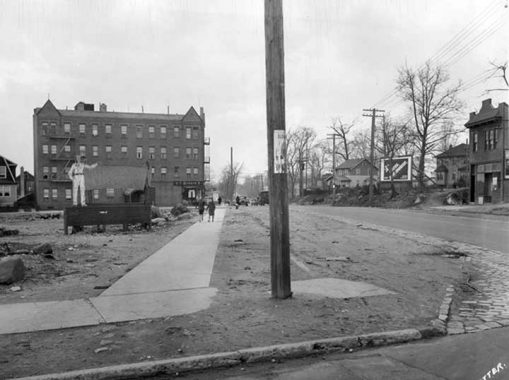
A few years ago, I reached into the archives to feature a photo from 1932 featuring a sign pointing to Glenn Curtiss Airfield, which is now the mighty LaGuardia Airport. I’ll show that here with my notes from that day, as well as a couple new photos never before shown.
LAGUARDIA Airport was constructed in 1929 as Glenn Curtiss Field, and later, North Beach Airport, replacing a former North Beach amusement area called the Gala Amusement Park, opened in 1889 by piano master William Steinway and beer baron George Ehret; it fell flat when Prohibition was enacted in 1920. The North Beach area and park were served by the Brooklyn City Railroad, which operated a trolley line along Old Bowery Bay Road, once one of the only thoroughfares in eastern Jackson Heights and East Elmhurst. The line survived into the 1930s and served the airport for a time. The airport was expanded to a full-service NYC airport beginning in 1939, and is currently undergoing massive renovations that will add new terminals and other amenities.
Glenn Curtiss (1878-1930) was a motorcycle manufacturer who became an early aviation pioneer.
On July 4 [1908], Curtiss piloted the “June Bug” across Pleasant Valley for a distance of 5,090 feet – 1,810 feet farther than required. No less important, it was the first officially-recognized, pre-announced and publicly-observed flight in America. It won Curtiss the first leg of the trophy and established him as America’s foremost aviation pioneer. In 1909, he flew his “Golden Flyer” a distance of 24.7 miles to establish a new world distance record and win the second leg of the Scientific American trophy. Later that same year, in Rheims, France, competing against Europe’s top aviators, he won the Gordon Bennet Cup speed race, averaging 46 mph. In 1910, when the New York World Newspaper offered a $10,000 prize for the first successful flight between Albany and NYC, following the Hudson River, Curtiss again determined to be first, and did so in a craft he had named the “Hudson Flyer”. He won the prize money, nationwide recognition, and in the process, won the third leg of the Scientific American Competition and permanent possession of the coveted trophy. It was his much-publicized Albany to New York flight that established the aeroplane as having some practical value. [Glenn Curtiss Museum]
There’s a lot going on in this 1932 photo looking west at Astoria Boulevard at 94th Street. At left, a billboard points the way to Glenn Curtiss Airport. In 2020, 94th Street remains an important approach point to LGA from the south and was also part of the route the streetcar line took to get to North Beach.
The apartment building with the peaked cornices at 93rd Street remains in place, as well as the private home yo the right of the billboard across Astoria Boulevard.
At the time, Astoria Boulevard was still a modest two-lane highway. Change is in the offing, however. You can see that ground has been cleared to the right of the telephone pole in the foreground. this was part of Astoria Boulevard’s expansion into a 6-lane behemoth, 8 if you count the parking lanes, all part of the construction of the Grand Central Parkway through Queens in the 1930s. West of 80th Street, Astoria Boulevard serves as the GCP’s service lanes. In the 1930s, transportation was quickly moving away from the old horse and buggy days to fossil fuel powered automotive and flying vehicles. Environmental ramifications for all this are under discussion in the 2020s.
The photo was snapped by Edgar E. Rutter (1883-1964), official Brooklyn photographer who also exposed photos all over NYC; I look to Rutter as well as Eugene Armbruster and Percy L. Sperr as inspirations for my own work.

Nearby was this pizzeria (spelled incorrectly on one of the signs) that served travelers en route, or coming back, from Curtiss Airport. Note that the Coca-Cola script logo has remained essentially unchanged since 1932.
The Airport Garage was also nearby. Note the single gas pump in the alley. What would “9 for $1.00 & tax” indicate? Comments are open.
The Grand Central Parkway, built along Astoria Boulevard in the 1930s under direction of NYC traffic czar Robert Moses, would obliterate the pizzeria and garage.
As always, “comment…as you see fit.” I earn a small payment when you click on any ad on the site.
7/29/23
